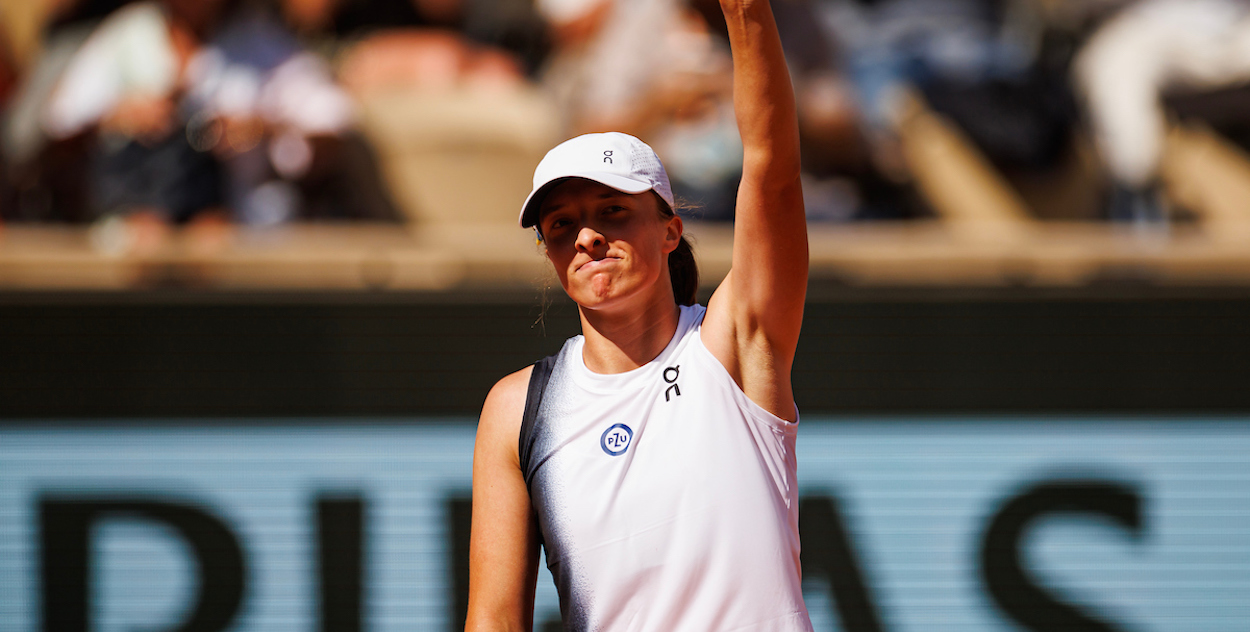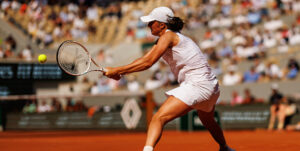
What makes Iga Swiatek so dominant at Roland Garros?
Iga Swiatek is a two-time Roland Garros champion, and with her ‘double bagel’ victory over Xinyu Wang the Pole kept up her 100% record of making the fourth round at the Paris major.
With the help of Craig O’Shannessy of Brain Game Tennis, we at Tennishead wanted to investigate what makes the world No.1 so dominant at the tournament.
Swiatek’s superpower is her return of serve. The defending champion has won her first three matches in straight sets, with four of those sets being 6-0.
Her fourth round match is against Lesia Tsurenko – an opponent she holds a 2-0 record against, with two of the four sets also sporting a 6-0 scoreline.
Here are six things you need to know about Swiatek’s return prowess at Roland Garros through the first three rounds:
1) Iga Swiatek owns her opponent’s 1st Serve
Typically, players don’t get to enjoy a winning percentage against their opponent’s first serve. The tournament average for women is only winning 39% against first serves, it’s even lower at 32% for men.
But Swiatek is devouring her opponent’s first serve, winning a jaw-dropping 60% (45/75) of these points. It’s an incredible stat that makes you double-check the numbers. Incredibly, she is not in first place in this statistical category. Her upcoming opponent, Tsurenko, has won 61% (57/93) of first serve return points.
2) Iga Swiatek also owns her opponent’s 2nd Serve
When her opponents miss their first serve, Swiatek dines on the 2nd serve, winning almost three out of four. Swiatek is in second place in this category leading into the Round of 16, winning a dominant 71% (39/55) of 2nd serve points.
The tournament leader is Sara Sorribes Tormo, who has won 73% (29/40). Those stats are well above the tournament average of 57% 2nd serve return points won.

3) Lack of Opponent Aces & Double Faults
Opponents have only hit two aces against Swiatek in six sets of tennis. They have also double faulted six times, which is not a lot, but it certainly starts the ball rolling in the wrong direction.
4) Iga Swiatek Return Winners & Errors
Swiatek has hit nine return winners in six sets. It’s a solid total and certainly signals her intention that she is coming after your service game beginning with the first shot. Swiatek has only committed 18 return errors in six sets of tennis, so right at three a set. That’s extremely efficient tennis.
5) Lack of Opponent Serve +1 Winners & Errors
This is an interesting match metric squarely focused on the first shot after the serve (Serve +1) for her opponent. The three opponents have combined to hit three Serve +1 winners, but have committed 24 Serve +1 errors. Swiatek is clearly bringing pressure with the return that forces immediate errors.
Iga Swiatek in #RolandGarros so far:
RD1: 6-4 𝟲-𝟬
RD2: 6-4 𝟲-𝟬
RD3: 𝟲-𝟬 𝟲-𝟬@iga_swiatek, 𝗕𝗮𝗴𝗲𝗹 𝗤𝘂𝗲𝗲𝗻 🥯👑 pic.twitter.com/sP9xoG7CSv— Eurosport (@eurosport) June 3, 2023
6) Iga Swiatek Return +1 Shot Winners & Errors
Once Swiatek has her return back in play, the next shot she is going to hit is a Return +1 groundstroke. The Pole has struck nine winners at this specific moment of the rally while only yielding 10 errors. Swiatek gives you absolutely no time to get into the rally.
Swiatek is the prohibitive favorite to win Roland Garros again this year. She has broken her opponent’s serve 18 of 22 times (82%). She has held 18 of 22 times herself. At the end of the first week, it’s her tournament to lose.
 For free access to Craig O’Shannessy’s complete courses on ‘25 Golden Rules of Singles‘ and ‘25 Golden Rules of Doubles‘, join thousands of other keen amateur tennis players and become a member of the Tennishead Club. Once you join we’ll immediately send you ground breaking coaching advice, a welcome pack including a full ASICS head to toe outfit including shoes, plus loads more. And it costs as little as £65/$97 to join with membership benefits worth over £600/$700 per year!
For free access to Craig O’Shannessy’s complete courses on ‘25 Golden Rules of Singles‘ and ‘25 Golden Rules of Doubles‘, join thousands of other keen amateur tennis players and become a member of the Tennishead Club. Once you join we’ll immediately send you ground breaking coaching advice, a welcome pack including a full ASICS head to toe outfit including shoes, plus loads more. And it costs as little as £65/$97 to join with membership benefits worth over £600/$700 per year!
Craig O’Shannessy is the creator of Brain Game Tennis. For 20 years he’s been involved in tennis as a coach to players like Kevin Anderson and even Dustin Brown when he famously beat Rafa Nadal at Wimbledon. More recently Craig’s been working as a match analyst at Wimbledon and for the ATP Tour. He has also used the unique insights from his match analysis software dartfish to guide players such as Novak Djokovic with analysis of opponents and performances.
Visit BrainGameTennis.com to read the latest and best selling course ‘Getting Tight’ where Craig teams up with Jeff Greenwald to combine their specific skill sets to help you with the universal problem all players struggle with in matches.
![]() Join >> Receive $700/£600 of tennis gear from the Tennishead CLUB
Join >> Receive $700/£600 of tennis gear from the Tennishead CLUB
![]() Social >> Facebook, Twitter & YouTube
Social >> Facebook, Twitter & YouTube
![]() Read >> World’s best tennis magazine
Read >> World’s best tennis magazine
![]() Shop >> Lowest price tennis gear from our trusted partner
Shop >> Lowest price tennis gear from our trusted partner


